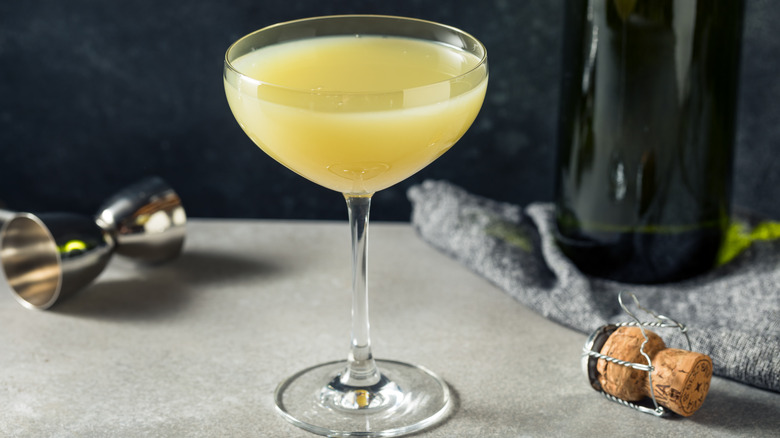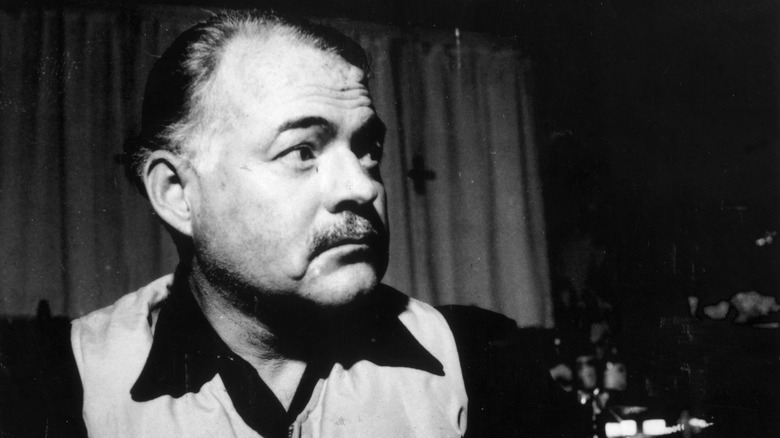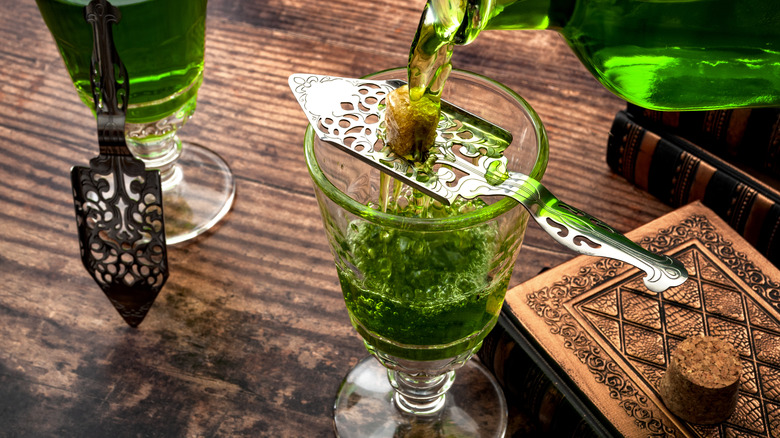Why The Death In The Afternoon Cocktail Has Such A Morbid Name
When contemplating the numerous cocktails you can order at the bar, drinks like the margarita or daiquiri might come to mind. Or when you're craving a Fridge Clean-Out cocktail you can easily make at home, you may combine leftover spirits and wines with mixers like Coca-Cola or sparkling water for an effortless yet innovative drink. But among the vast history of cocktails, if there's one that raises eyebrows and conjures an air of mystery, it's the infamous Death in the Afternoon. This evocative drink boasts an unusual origin tied to none other than Ernest Hemingway, one of the 20th century's most iconic literary figures. And he didn't just create the cocktail — he named it too.
Hemingway named the drink after his 1932 non-fiction book "Death in the Afternoon," a passionate account of the history of Spanish bullfighting. The work captured the essence of life, danger, and art, mirroring the thrill that he found not only in the corrida but in all aspects of his life. Despite its early inception, the timeless drink is still widely known and enjoyed by many, not just for its potent profile and cloudy appearance but for its compelling name, which tells a dark story of its own.
How did the cocktail get its name?
Ernest Hemingway's two-ingredient cocktail — consisting of absinthe and champagne — was emblematic of the early 1900s. It was even featured in "So Red the Nose, or Breath in the Afternoon," a 1935 compilation of cocktail recipes created by celebrity writers. In the entry, Hemingway wrote of the drink: "Pour one jigger (equivalent to 1 and 1/2 ounce) absinthe into a Champagne glass. Add iced Champagne until it attains the proper opalescent milkiness. Drink three to five of these slowly." It seems a bit excessive for someone to recommend drinking more than three cocktails in one sitting, let alone one as precarious as Hemingway's Death in the Afternoon. But there's a reason why he suggested such a dosage, and it sheds light on his adventurous spirit and affinity for high-stakes activities
Hemingway drew inspiration for this simple but strong cocktail with the collaboration of Captain Edward Saunders and three other officers while aboard the H.M.S Danae, the British Navy's light cruiser. After getting caught in a storm, Hemingway and the three officers spent seven hours trying to free Captain Saunders' boat. Within that time, they directed their focus to a more light-hearted topic — mixology. They collectively ideated grandiose cocktails as they navigated the storm, and it was then that they created the Death in the Afternoon.
Why did Hemingway choose absinthe as his cocktail mixer?
Ernest Hemingway incorporated absinthe — a 110-proof light green liquor (55% ABV) — into this original cocktail after encountering the enthralling spirit in Paris, France and Spain in the 1920s. French physician Pierre Ordinaire invented the drink in Switzerland circa 1792 and intended it to be used as a medicine. One of its ingredients is wormwood (Artemisia absinthium), an herb known for various health benefits like improving digestion and treating fevers and liver diseases.
At the time, absinthe was portrayed as a dangerous, addictive substance because of the convulsant effects of one of wormwood's chemical compounds, thujone, and the plant's perceived hallucinogenic properties (this myth has recently been debunked). Though the spirit continued to grow in recreational popularity in Switzerland, France, and the U.S. during the late 1800s, it was banned in multiple countries in the early 1900s after excessive consumption led to deaths. Around the 1990s, countries began to revise and lift these bans after the European Union reauthorized its manufacture and sale. And in 2008 and a study published in the Journal of Agricultural and Food Chemistry confirmed that the danger lay in absinthe's excessive amount of ethanol and concluded that thujone was not responsible for the spirit's reported psychedelic effects.
Hemingway's combination of absinthe's harsh and aromatic flavors with dry, bubbly wine makes for a strong but refreshing combination that people just couldn't resist. Upon gaining a deeper understanding of the cocktail's backstory, it's no wonder why Hemingway gave it such a morbid name. The choice to name a cocktail after the concept of life and death was typical of his penchant for drama. The drink is an ode to risk, adventure, and indulgence, embodying the razor's edge between excitement and danger that Hemingway loved.


